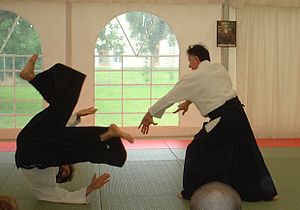Kiai
This article needs additional citations for verification. (June 2008) |
| Kiai | |||||||
|---|---|---|---|---|---|---|---|
 Kiai can be used to aid a martial arts technique such as the throw above. | |||||||
| Korean name | |||||||
| Hangul | 기합 | ||||||
| Hanja | 氣合 | ||||||
| |||||||
| Japanese name | |||||||
| Kanji | 気合 | ||||||
| Hiragana | きあい | ||||||
| |||||||
Kiai (気合) /ˈkiː.aɪ/ (pronounced "key-eye") is a Japanese term used in martial arts and other sports and games. There are numerous examples of the battle cry in other cultures: kiai is perhaps primarily a development of this. In the representation of Asian martial arts in cinema and in animated cartoons, Modern Kiai are often written by westerners in Romaji as Hi-yah!, Aiyah!, Eeee-yah!, or Hyah!, however there are no specific sounds involved. Those used are chosen by the individual practitioner. Traditional Japanese Dojo generally use single syllables beginning with a vowel. In the board game Go the term describes fighting spirit.[1]
Use in martial arts
In martial arts, the term commonly refers to a short yell made before, during, or after a technique.
Students of Japanese martial arts such as aikido, karate, kobudo, kendo, or judo (or related arts such as taiko drumming) use kiai to startle an opponent, intimidate, express confidence, or express victory. In kendo, for example, a point is only given by the Shinpan (referees) if the hit is accompanied by a strong, convincing kiai. The physical aspects of a kiai are often thought to teach a student proper breathing technique when executing an attack. This is especially useful for longer series of attacks such as kirikaeshi, Kakari geiko (rapid partner exercise creating openings) and uchikomi geiko (responding fast to openings made by the partner).
Mental imagery techniques are used to teach the martial artist to imagine starting a kiai in the hara or dantien-Chinese; from a physiological perspective, this means the yell should start in the diaphragm, not the throat.
Etymology
Kiai is a compound of ki (気) meaning energy or mood, a(u)(合), meaning join or fit. Frederick John Lovret notes, "One should note that ai, the conjunctive stem of the verb au, does not mean "to join" in this case: when used in the second position of a compound word, ai becomes an emphatic marker. Kiai, therefore, is an energetic yell.
The sound is called K'ihap in many Korean martial arts, such as taekwondo. This is derived from the old Korean reading of the same arrangement of Chinese characters as had been used to write kiai in Japanese. In the phonetic alphabet of modern Korean it is written as 기합, and in Hanja it is written as 氣合.
Kiai and aiki

The two terms Kiai and aiki use the same kanji (transposed) and can be thought of as the inner and the outer aspect of the same principle.[2] Some martial arts schools use the term interchangeably. Otherwise Kiai relates to the manifestation, emission or projection of ones own energy (internal strength), while Aiki relates to the coordination of one's energy with the energy of an external source. Thus kiai is the expression or projection of our own, internal energy while aiki is coordination with an attacker's energy.
This usage of kiai as internal strength, or using one's ki[3] is often found in aiki arts such as aikijujutsu and aikido.[4] In some schools such as the Ki Society, 'keeping one point' (awareness or centredness in the dantian) is described as kiai.[5]
Fictional portrayals
The art of kiai is a main focal point of the novel "The Samurai's Wife" by Laura Joh Rowland. In the novel, the main character, Sano Ichiro, is sent to the Imperial Court in Kyoto, Japan to investigate the death of an Imperial official who died at the hands of a kiai scream. He discovers that in this case Momozono (the nephew of the Emperor) who appears to be handicapped actually possesses the ability to emit a kiai scream. Sano believes this to be a biological gift rather than one of discipline although there were signs of Momozono practising such as fallen birds in the courtyard of the palace.
References
- ^ Kiai, Sensei's Library (Go resource).
- ^ Kiai vs aiki
- ^ Using one's Ki
- ^ Use in aiki arts
- ^ Kiai as 'Keeping One Point'
Further reading
- Don Oberloh "The Dojo Desk Reference- Translation of "Hyaku Jiten no Bugei" by Sakiyama Akatsuki. Densho Publications Honolulu, Hi. (2006) ISBN 0-9787198-0-8, Library of Congress # 200669487324 This book is now available as an ebook through Lulu, iTunes and Barnes and Noble.
- E.J. Harrison, The Fighting Spirit of Japan Overlook TP; Reprint edition (1988) ISBN 0-87951-154-0
- Forrest E. Morgan, Living the Martial Way: A Manual for the Way a Modern Warrior Should Think,Barricade Books, 1992, ISBN 0-942637-76-3
